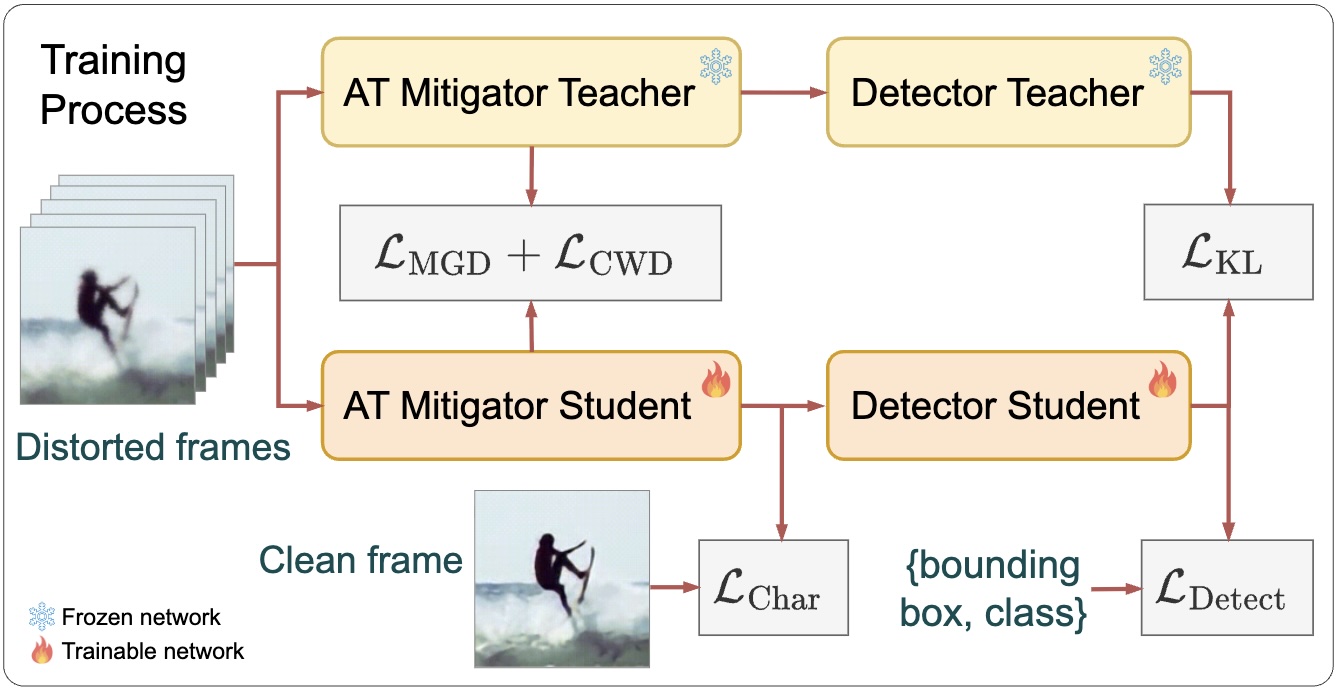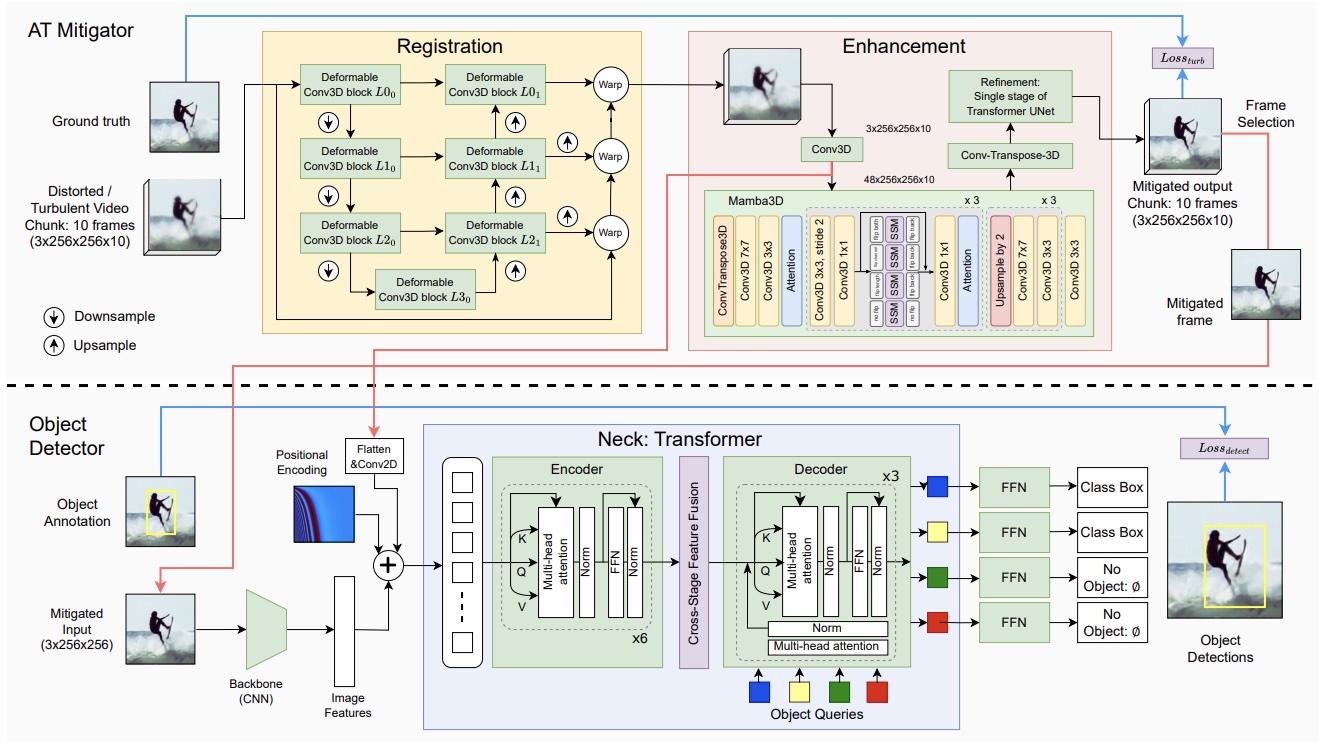
Aim
Atmospheric turbulence distorts visual imagery, posing significant challenges for information interpretation by both humans and machines. Traditional approaches to mitigating atmospheric turbulence are predominantly model-based, such as CLEAR, but are computationally intensive and memory-demanding, making real-time operations impractical. In contrast, deep learning-based methods have garnered increasing attention but are currently effective primarily for static scenes. This project proposes novel learning-based frameworks specifically designed to support dynamic scenes.
Our objectives are twofold: (i) to develop real-time video restoration techniques that mitigate spatio-temporal distortions, enhancing the visual interpretation of scenes for human observers, and (ii) to support decision-making by implementing and evaluating real-time object recognition and tracking using the restored video.
Methods
- RMFAT: Recurrent Multi-scale Feature Atmospheric Turbulence Mitigator (AAAI2026)

RMFAT, a Recurrent Multi-scale Feature Atmospheric Turbulence Mitigator, restores videos efficiently and consistently by using a lightweight two-input recurrent framework with multi-scale feature encoding and temporal warping to enhance spatial detail and temporal coherence.
- MAMAT: 3D Mamba-Based Atmospheric Turbulence Removal and its Object Detection Capability (AVSS2025) [PDF] [Code]

MAMAT is a novel Mamba-based method in which the first module employs deformable 3D convolutions for non-rigid registration to reduce spatial shifts, while the second module enhances contrast and detail. Leveraging the advanced capabilities of the 3D Mamba architecture, experimental results demonstrate that MAMAT outperforms state-of-the-art learning-based methods.
- JDATT: A Joint Distillation Framework for Atmospheric Turbulence Mitigation and Target Detection. (BMVC2025)
[ PDF] 
JDATT is a knowledge distillation framework designed to reduce model size and improve inference speed. We introduce a joint end-to-end training strategy that preserves image quality through reconstruction loss, Channel-Wise Distillation loss, and Masked Generative Distillation loss, while maintaining detection performance via detection loss and Kullback–Leibler divergence..
- DMAT: An End-to-End Framework for Joint Atmospheric Turbulence Mitigation and Object Detection. (WACV2026)

DMAT is an end-to-end framework that jointly improves visual quality and object detection by compensating for distorted features. It enables knowledge exchange between low-level distortion correction in the atmospheric turbulence mitigator and high-level semantic features from the detector. The AT mitigator employs a 3D Mamba-based architecture to model spatio-temporal turbulence effects, and the entire system is optimised jointly.
- DeTurb: Atmospheric Turbulence Mitigation with Deformable 3D Convolutions and 3D Swin Transformers (ACCV2024)

The DeTurb framework combines geometric restoration with an enhancement module. Random perturbations and geometric distortions are corrected using a pyramid architecture with deformable 3D convolutions, producing aligned frames. These frames are then reconstructed into a sharp, clear image through a multi-scale 3D Swin Transformer architecture.
Research team
Core
- N. Anantrasirichai: Lead academic
- D.R. Bull and A. Achim: Co-Lead academics
- Paul Hill: Postdoctoral researcher [Review paper
] [Paper1] [Paper2] [ Real dataset] [Synthetic datasets] - Zhiming Liu: Research associate [Paper1] [Paper2]
Undergrad/Postgrad projects
- Zhiming Liu (2025), Joint Distillation Framework for Turbulence Mitigation and Target Detection [Paper
] - Zhicheng (Frederick) Zou (2024), Enhancing Long-Range Imaging through Deep Learning: Mitigating Atmospheric Turbulence [Paper] [Code]
- Disen Hu (2022), Atmospheric Turbulence Object Detection in Video Using Deep Learning [Paper]
- Rachel Lin (2022), Dealing with Atmospheric Turbulence Distortion in Video Sequences
- Haziq I.B.Mohammed Shafri (2020), Multi-Input Denoising for Atmospheric Turbulence Mitigation in Video
- Jingxuan Wang (2020), Atmospheric turbulence mitigation in video using deep learning
- Jing Gao (2019), Atmospheric turbulence removal using convolutional neural network [arXiv]
Downloads
Publications
- RMFAT: Recurrent Multi-scale Feature Atmospheric Turbulence Mitigator. Z Liu, N Anantrasirichai, AAAI Conference on Artificial Intelligence. 2026
[ PDF] [Project] [Code] - DMAT: An End-to-End Framework for Joint Atmospheric Turbulence Mitigation and Object Detection. P Hill, Z Liu, A Achim, D Bull, N Anantrasirichai, IEEE/CVF Winter Conference on Applications of Computer Vision. 2026
[ PDF] [ CODE] [Dataset]- JDATT: A Joint Distillation Framework for Atmospheric Turbulence Mitigation and Target Detection. Z Liu, P Hill, N Anantrasirichai, 36th British Machine Vision Conference. 2025
[ PDF] - MAMAT: 3D Mamba-Based Atmospheric Turbulence Removal and its Object Detection Capability. P Hill, Z Liu, N Anantrasirichai, 21st IEEE International Conference on Advanced Visual and Signal-Based Systems, 2025 [PDF] [Code]
- Deep Learning Techniques for Atmospheric Turbulence Removal: A Review. P Hill, N Anantrasirichai, A Achim, D Bull. Artificial Intelligence Review. 2025
[ PDF] [ATD Dataset]- DeTurb: Atmospheric Turbulence Mitigation with Deformable 3D Convolutions and 3D Swin Transformers. Z. Zou and N. Anantrasirichai, Asian Conference on Computer Vision, 2024
[ PDF] [Code] [ATD Dataset]- Atmospheric Turbulence Removal with Complex-Valued Convolutional Neural Network. N. Anantrasirichai, Pattern Recognition Letters. 2023
[ PDF] - Object Recognition in Atmospheric Turbulence Scenes. D. Hu and N. Anantrasirichai, European Signal Processing Conference. 2023.
[ PDF] [ Code] - DMAT: An End-to-End Framework for Joint Atmospheric Turbulence Mitigation and Object Detection. P Hill, Z Liu, A Achim, D Bull, N Anantrasirichai, IEEE/CVF Winter Conference on Applications of Computer Vision. 2026
Datasets
Related research
Related project
- CLEAR: Model-based methods for mitigating atmospheric distortions using Dual Tree Complex Wavelet Transform (DT-CWT)
Related publications from VI-Lab
- A unified framework for contextual lighting, colorization and denoising for UHD sequences . N Anantrasirichai and D R Bull. IEEE ICIP, 2021
- Artificial intelligence in the creative industries: A review. N Anantrasirichai and D R Bull, Artif Intell Rev 55, 2022
- ST-MFNet Mini: Knowledge distillation-driven frame interpolation. C Morris, D Danier, F Zhang, N Anantrasirichai, D R Bull. IEEE International Conference on Image Processing. 2023